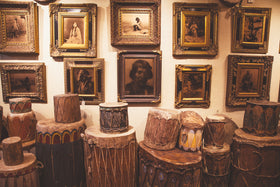Walking Canes: From Practical Aid to Symbol of Status and Defense

Walking canes have a varied history that spans centuries and continents. What started as a simple aid for mobility has evolved into an emblem of social status, a piece of art, and even a weapon for self-defense
Ancient Origins: The Practical Aid
The earliest canes date back to ancient civilizations where they primarily served as walking aids. In Egypt, depictions of pharaohs and gods with staffs symbolized power and authority. Similarly, the Greeks and Romans used canes not only for support but also as a sign of distinction among the elite.
The 18th / 19th Centuries: Status Symbols, Art Pieces and Defense
Status Pieces: The 18th and 19th centuries marked the golden age of the walking cane. During this period, canes became a crucial accessory for the fashionable gentleman. They were crafted from exquisite materials like ebony, ivory, and gold, often featuring intricate carvings and inlays. Carved ivory-handled canes were popular among the affluent, serving as both a walking aid and a status symbol.

Sword Canes: Some canes began to take on more specialized roles. One intriguing development was the sword cane - a discreet weapon hidden within an ordinary-looking cane. Nobles and gentlemen found sword canes invaluable, providing a means of self-defense while maintaining an air of sophistication.

Gun Canes: The 19th century also saw the emergence of gun canes, blending the traditional cane with the functionality of a firearm. These canes, often favored by spies and adventurers, added a layer of intrigue and danger to the otherwise humble walking stick. River boat gamblers were known to carry gun canes for defense as well as recreation. Some gun canes from this time included lightweight stocks that could be attached for better accuracy when firing upon various wild game found along the shoreline.

Novelty Canes: The Multifunctional Marvels
Victorians were known for their ingenuity, which extended to the creation of novelty canes. These multifunctional canes were not only walking aids but also concealed various tools and gadgets. Some notable examples include:
Flask Canes: Perfect for a secret sip on the go.
Fishing Rod Canes: A hidden fishing rod for spontaneous anglers.
Picnic Canes: Equipped with utensils and compartments for an impromptu outdoor meal.
Doctor’s Kit Canes: Containing medical tools for the traveling physician.
Today: A Blend of Tradition and Modernity
In contemporary times, walking canes continue to serve various purposes. While modern mobility aids focus on ergonomics and functionality, antique and custom-made canes remain cherished collectibles and symbols of elegance. Artisans craft bespoke canes that are both practical and visually stunning, ensuring the walking cane’s legacy as a versatile and treasured accessory endures.
From their early days as simple walking aids to their evolution into weapons, art pieces, and novelty items, walking canes have a storied history that reflects the ingenuity and creativity of their users. Whether used for support, self-defense, or as a status symbol, the walking cane remains a fascinating artifact of human culture.
Click here to view Cisco's collection of vintage and antique canes







